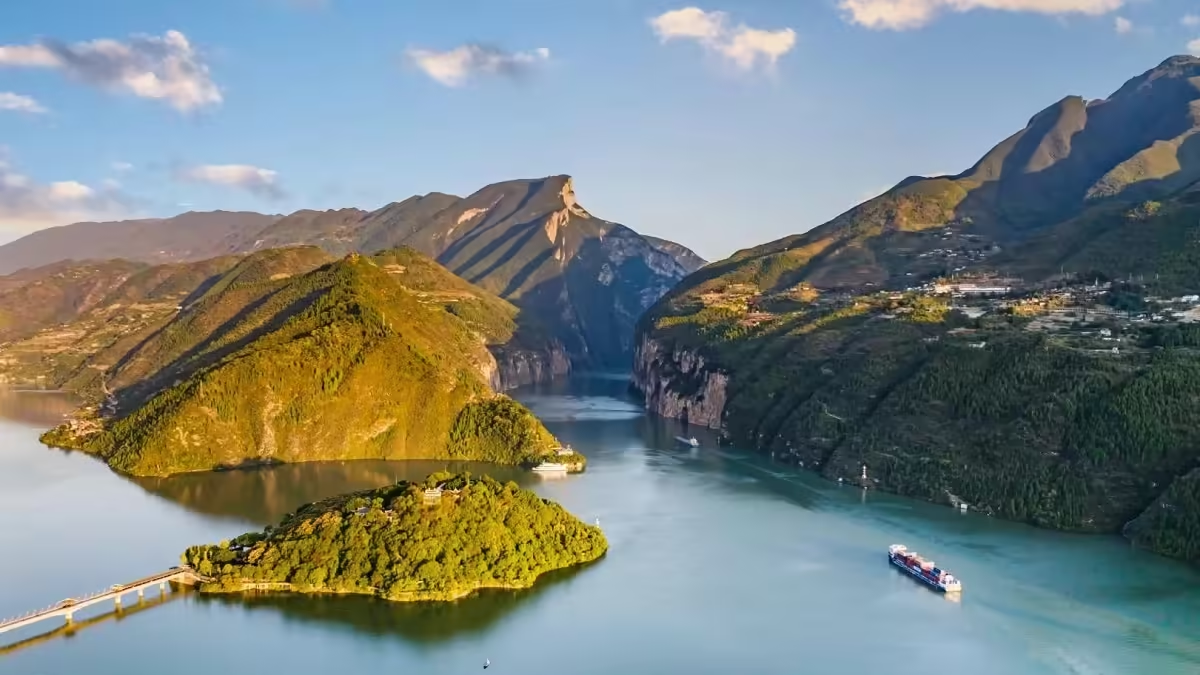The Three Gorges (三峡), famously described by Chinese author Yu Qiuyu in A Bitter Journey Through Culture, is one of the most remarkable natural wonders in China. When asked by foreign friends about the most fascinating place in China, he often answered “the Three Gorges.”
Located in the heart of China, the Three Gorges span from Baidi City in Fengjie, Chongqing, to Nanjin Pass in Yichang, Hubei, stretching about 200 kilometers. This scenic area consists of three major gorges: Qutang Gorge, Wu Gorge, and Xiling Gorge, forming what is known as the “Great Three Gorges.” The region is renowned for its breathtaking landscapes, where towering peaks rise 1,000 to 1,500 meters above the river, with narrow sections less than 100 meters wide. The Yangtze River cuts through this rugged terrain, creating fast-flowing, treacherous waters dotted with rocks and reefs, making the area rich in hydropower resources.
Historically, the Three Gorges have been home to great military strategists and heroes, serving as battlegrounds during the Three Kingdoms era. Famous landmarks like Baidi City, Huangling Temple, Nanjin Pass, and Lady Sun Temple add cultural depth to the area’s natural beauty, creating a fusion of history and nature that attracts visitors from all over the world.
Known for its dramatic landscapes, powerful waterways, and historical significance, the Three Gorges is recognized as one of the world’s most famous tourist destinations and one of China’s top travel highlights. Its stunning scenery and cultural landmarks make it a must-visit for anyone seeking to experience China’s grandeur.
Travel Information about the Three Gorges
Ticket and Opening Hours
| Attraction | Ticket Price | Opening Hours |
|---|---|---|
| Shennv Stream (Goddess Stream) | ¥180 | 7:30 AM – 3:00 PM |
| Baidi City | ¥90 (Peak), ¥50 (Off-season) | 8:30 AM – 5:00 PM |
| Wushan Three Little Gorges | ¥113 | 8:00 AM – 2:00 PM |
| Fengdu Ghost City | ¥100 | 6:30 AM – 5:00 PM |
| Zhang Fei Temple | ¥32 | 8:00 AM – 5:30 PM |
| Tiankeng (Heavenly Pit) | ¥124 | 8:00 AM – 5:00 PM |
| Difeng (Earth Rift) | ¥115 | 8:00 AM – 5:00 PM |
Best Time to Visit
The prime time to explore the Three Gorges is between April and December, which is the high season for tourism. During the wet season, the river’s water level rises, enhancing the beauty of the gorges. Each season offers unique charm: in autumn, the red leaves covering the gorge walls are a major highlight. Festivals and events are also held during certain holidays, adding to the experience.
Attraction Ratings
- Unique: ★★★★★
- Scenic Beauty: ★★★★★
- Leisure: ★★★★★
- Cultural: ★★★★
- Romantic: ★★★★
- Thrill: ★★
Highlights of the Three Gorges
Wu Gorge
Wu Gorge, located between Wushan in Chongqing and Badong in Hubei, stretches 45 kilometers from the mouth of the Daning River in the east of Wushan to Guandukou in Badong. It includes the Jinlan Silver Armor Gorge and the Iron Coffin Gorge. The gorge is particularly deep and winding, formed by the Yangtze River cutting through the anticlinal structure of the Wushan mountain range. Also known as the Grand Gorge, Wu Gorge is famous for its serene beauty. Its towering peaks, rugged cliffs, and continuous rock formations make it the most picturesque section of the Three Gorges, resembling a winding gallery filled with poetic charm. Each part of Wu Gorge presents a unique scenic view, with landscapes flowing seamlessly into one another.
Qutang Gorge
Qutang Gorge, also known as Kwei Gorge, extends 8 kilometers from Daxi Town in Wushan County to Baidi City in Fengjie County. Although the shortest of the Three Gorges, it is renowned for its grandeur and steepness. The cliffs on both sides rise dramatically, presenting a striking contrast between red and white rock formations. The towering mountains confine the Yangtze River, creating a swift and powerful flow. Qutang Gorge is celebrated for its breathtaking scenery and distinctive features of majesty, uniqueness, and peril, making it a world-renowned destination.
Xiling Gorge
Xiling Gorge is located in the Zigui County of Yichang City, Hubei Province. Stretching approximately 66 kilometers from Xiangxikou in the west to Nanjinguan in the east, it is the longest gorge in the Three Gorges and is famous for its many rapids and steep terrain. The gorge features a landscape of high mountains, deep valleys, and treacherous rocks. Within the gorge, there are sub-gorges, creating a layered effect of large and small gorges, as well as numerous rapids of varying sizes. From west to east, notable sections include the Bingshu Baojian Gorge, Niugan Malung Gorge, Kongling Gorge, and Dengying Gorge, along with perilous rapids such as Qingtan, Xietan, Konglingtan, and Yaohanhe.
Three Gorges Dam
The Three Gorges Dam Tourist Area officially opened to the public in 1997 and is recognized as a National 5A-level tourist attraction. Covering a total area of 15.28 square kilometers, the tourist area features five zones: the Three Gorges Exhibition Hall, Tanjiling Park, the 185 Park, the Near Dam Park, and the Sluicing Memorial Park. Leveraging the world’s largest water conservancy project, the Three Gorges Project, this area comprehensively showcases engineering culture and hydraulic culture. It provides visitors with a multifunctional service experience that includes sightseeing, educational activities, leisure, and entertainment. The area integrates modern engineering, natural scenery, and cultural landscapes, making it a sought-after destination for both domestic and international tourists.
Visitor Guide for the Three Gorges
Boat Cruise on the Three Gorges
Location: The cruise route stretches from Baidi City in Fengjie, Chongqing, in the west to Nanjin Pass in Yichang, Hubei, in the east.
1. Departure Point Selection: For the best experience, it is recommended to choose a downstream route departing from Chongqing rather than an upstream route from Shanghai, Nanjing, or Wuhan. This is because upstream navigation has a slower speed, making it difficult to fully enjoy the refreshing breeze and the exhilarating feeling of “light boats passing through thousands of mountains.” Traveling through the Three Gorges is akin to experiencing life; the most beautiful memories often come from fleeting moments.
2. Tour Method: Most attractions along the Three Gorges are located on both banks of the Yangtze River, and the usual way to explore the area is by boat. Although the completion of the Three Gorges Dam has made the river less turbulent, travelers should avoid visiting if they are unwell. While enjoying the evening breeze on the river can be delightful, the winds can be chilly, so it’s advisable to dress warmly to prevent catching a cold. Many attractions require visitors to disembark and hike, so wearing sports shoes is recommended to avoid falls.
3. Choosing a Cruise Ship: There are two types of cruise ships operating on the Yangtze River: domestic ships and international cruise liners. Domestic ships, also known as ordinary cruise ships, are divided into four classes: third-class cabins accommodate six people, second-class cabins house four, first-class cabins are for two, and deluxe cabins feature large beds or standard rooms. Ticket prices range from 450 to 1,300 yuan per person, with meal costs around 200 yuan per person, making them suitable for budget travelers. International cruise liners, referred to as luxury cruise ships, are designed to meet hotel standards.
4. Shopping Tips:The tourism management department in the Three Gorges area enforces strict regulations, so visitors need not worry about forced shopping. There are upscale souvenir shops on the ships with slightly higher prices, but these are not traditional tourist traps; they are genuine stores where visitors can shop at their leisure. Outside major attractions, many vendors sell unique items for those interested in purchasing souvenirs.
5. Return Journey: Cruise ships typically dock on time, so travelers with flights do not need to worry. However, it is advisable to book return tickets in advance to ensure a smooth journey.
Activities on the Three Gorges
During the Yangtze River Three Gorges International Tourism Festival, various themed activities will take place, including a photography contest, self-driving tours around the gorges, and smart tourism initiatives. The festival will also feature unique events in the 14 districts and counties, such as the Changshou Lake International Triathlon in Chongqing and the “Romance of the Three Kingdoms” marketing activities in Zhongxian.
New attractions have emerged alongside traditional cruise stopovers, offering visitors fresh experiences. Notable sites include a large-scale live performance in Zhongxian, the Wuling Mountain Grand Canyon in Fuling, and Han Feng Lake in Kaixian. Additionally, newly planned land self-driving routes provide another option for exploring the Three Gorges, encompassing flower-viewing, ancient town leisure tours, and summer retreats, with specific itineraries available for those interested in local attractions and seasonal events.

